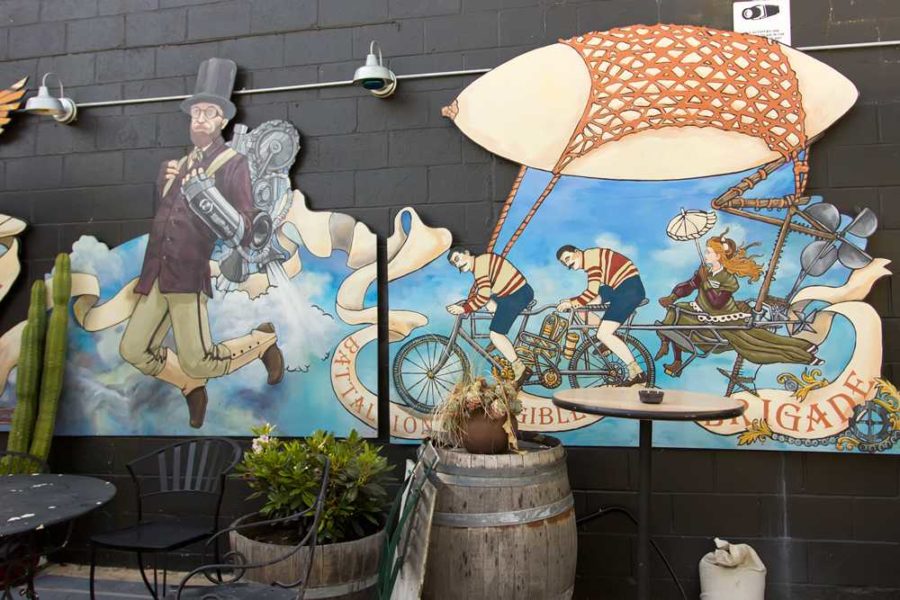The neighborhood next to Julliard Park on South A Street may be quiet, but the street art is loud with intricate designs, powerful political statements and bold mural paintings. Artists have slowly changed this neighborhood from the seedy edge of downtown Santa Rosa into a quiet art community.
And they won’t stop there.
The artists who work in the neighborhood also want it to be the hub of conversation, culture and change in Santa Rosa — and it’s not just the artists spurring the change.
Carol Porter, a spry woman with short grey hair and an inviting smile, has lived in this neighborhood for 22 years and witnessed its transformation.
She said the neighborhood used to be plagued with break-ins and killings.
Porter and her neighbors formed a neighborhood watch 20 years ago in the early ’90s when the first wave of artists moved into the area.
Since then, the residents of the neighborhood have seen a fluctuation of peace and crime, thriving businesses and abandoned buildings.
She puffed on a cigarette as she sat on her front porch with her feet up. “We’re a close-knit neighborhood,” Porter said.
Robin Factor and her husband Simmon are two of the more than 40 artists working in the area. They used to own Village Art before selling the business, retiring to their studio and joining the art community. The couple now has a working gallery called Chroma Gallery in the Studios at South A.
“If you’re talking about art community in Santa Rosa, this is ground zero. This is really where it’s happening as far as the visual arts,” Robin Factor said.
They are also members of an organization of artists and business owners in the South A Street neighborhood called SOFA, or South of A. Like the SoHo neighborhood in New York, SOFA promotes visibility for the studios and organizes art events. Robin Factor said the events are well attended, but on a day-to-day basis the neighborhood is pretty quiet.
The Factors’ story reflects the transformation throughout the neighborhood. The Studios at South A was an abandoned auto repair shop that artists renovated 20 years ago and is now home to eight art studios.
“Historically, artists move into an area where the property values are low, because you can afford to set up a studio,” Factor said. “We don’t make a lot [of] money.”
The artists’ reinvention of the neighborhood may seem like a case of gentrification, but grassroots activism changed this neighborhood from a dangerous area of town into a thriving yet peaceful arts district.
“It did get cleaned up a lot. There were a lot of addicts; there were alcoholics,” Simmon Factor said. “It’s a lot safer.”
Although Chroma Gallery is open to the public, Factor said that most studios are not regularly open to the public.
“People want to have brunch and walk around [and] look at art,” Factor said. “Right now, there’s hardly anybody open.”
The majority of Santa Rosa residents don’t know about the budding arts community at SOFA, but the Factors think opening up a few more restaurants and stores would help raise awareness about the neighborhood.
“It’s still a little bit underground,” Factor said. “We want to see this neighborhood go up a couple more notches, as far as occupancy, more retail businesses.”
Meanwhile, the neighborhood has already produced a success story.
Spinster Sisters, a modern American restaurant, joined the neighborhood in August 2012, and SOFA became one step closer to becoming an attractive destination for people from all over town.
Giovanni Cerrone, one of the three owners of Spinster Sisters, said more than 17,000 customers walked through their doors in 2013.
With expressive hand gestures and a slight Italian accent, Cerrone said he chose to open the restaurant in a part of town with a less-than-stellar reputation because it didn’t have vast parking lots or big box stores.
“Those things are soulless,” Cerrone said.
Cerrone, who moved from San Francisco to Santa Rosa 12 years ago, said the area has an urban feel unlike the suburban rest of Santa Rosa. “We feel that it is a culture we want to support,” he said.
Accordingly, he designed a large rectangular bar as a way to spark conversations and create a meeting point to talk about the future of Santa Rosa.
To follow his vision, paintings by local artists cover the walls, and a full bookshelf stands open to the public in the corner. Every two months new local artists display their work for sale, and once a month the restaurant hosts an author’s night.
Cerrone feels that his efforts can spark a cultural change in the city.
Cerrone also emphasized the importance of reaching out to the younger generation.
“[A] community has to engage with their youth. If everything that happens is decided by other people — culturally, politically, economically, they feel left out,” Cerrone said. “I think South A is a place where this can happen.”




